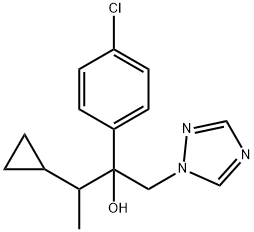|
ChemicalBook Optimization Suppliers |
|
| | rac-(2R*,3R*)-2-(4-クロロフェニル)-3-シクロプロピル-1-(1H-1,2,4-トリアゾール-1-イル)ブタン-2-オール 製品概要 |
| 化学名: | rac-(2R*,3R*)-2-(4-クロロフェニル)-3-シクロプロピル-1-(1H-1,2,4-トリアゾール-1-イル)ブタン-2-オール | | 英語化学名: | Cyproconazole | | 别名: | SHANDON;CYPROCONAZOLE;ALTO;1H-1,2,4-Triazole-1-ethanol, .alpha.-(4-chlorophenyl)-.alpha.-(1-cyclopropylethyl)-;(2RS,3RS:2RS,3RS)-2-(Chlorophenyl)-3-cy- clopropyl-1-(1H-1,2,4-triazol-1-yl)butan- 2-ol;2-(4-Chlorophenyl)-3-cyclopropyl-1-(1,2,4-triazol-1-yl)butan-2-ol;Alto 100;Alto 100SL | | CAS番号: | 94361-06-5 | | 分子式: | C15H18ClN3O | | 分子量: | 291.78 | | EINECS: | 619-020-1 | | カテゴリ情報: | CO - CZPesticides;Conazoles;Alpha sort;C;CAlphabetic;Fungicides;Pesticides&Metabolites;Pharmaceutical intermediate | | Mol File: | 94361-06-5.mol |  |
| | rac-(2R*,3R*)-2-(4-クロロフェニル)-3-シクロプロピル-1-(1H-1,2,4-トリアゾール-1-イル)ブタン-2-オール 物理性質 |
| 融点 | 108℃ | | 沸点 | >250℃ | | 比重(密度) | 1.32 | | 蒸気圧 | 3.46 x l0-5 Pa (20 °C) | | 屈折率 | 1.6330 (estimate) | | 闪点 | >100 °C | | 貯蔵温度 | Store at -20°C | | 溶解性 | Soluble in acetone, ethanol, xylene, and dimethyl sulfoxide. | | 水溶解度 | 140 mg l-1(25 °C) | | 酸解離定数(Pka) | 12.59±0.29(Predicted) | | BRN | 8396421 | | 安定性: | Hygroscopic | | LogP | 3.1 at 25℃ and pH7.2 | | CAS データベース | 94361-06-5(CAS DataBase Reference) | | EPAの化学物質情報 | Cyproconazole (94361-06-5) |
| 主な危険性 | Xn,N | | Rフレーズ | 22-50/53-63 | | Sフレーズ | 36/37-60-61-36 | | RIDADR | UN3077 9/PG 3 | | WGK Germany | 3 | | RTECS 番号 | XZ4803250 | | 国連危険物分類 | 9 | | 有毒物質データの | 94361-06-5(Hazardous Substances Data) | | 毒性 | LD50 in male and female rats (mg/kg): 1020, 1330 orally; in rats: 2000 dermally; LD50 in carp: 18.9 mg/l; in trout 7.2 mg/l; in bluegill sunfish 6.0 mg/l in water; LD50 in bobwhite quail (mg/kg): 150 orally; LD50 (8 day dietary) in bobwhite quail, mallard duck: 816, 1197 mg/kg (Gisi, 1986) |
| | rac-(2R*,3R*)-2-(4-クロロフェニル)-3-シクロプロピル-1-(1H-1,2,4-トリアゾール-1-イル)ブタン-2-オール Usage And Synthesis |
| 外観 | 白色, 結晶性粉末~粉末 | | 溶解性 | エタノール及びアセトンに溶けやすく、水に極めて溶けにくい。 | | 農薬用途 | 殺菌剤 | | 化学的特性 | Colorless, crystalline solid. Odorless. | | 使用 | Cyproconazole is a fungicide treatment for wood preservative that prevents decay from fungi in above-ground applications. | | 使用 | Cyproconazole is used to inhibit demeythylation in fungal sterol synthesis. And it is used on greenhouse and field-grown roses and as a wood preservative, surface application or pressure treatment of wood for above-ground uses, including siding, plywood, millwork, shingles, lumber. | | 使用 | Cyproconazole is used as a systemic fungicide to control cereal
and sugar beet foliar diseases: Septoria, rust, powdery mildew, Rhyncosporium,
Cercospora and Ramularia. It is also used in fruit trees, vines,
coffee, banana, turf, and vegetables to control Venturia, powdery mildew,
rust, Mycosphaerela, Monilia, Mycena, Sclerotinia and Rhizoctonia. | | 定義 | ChEBI: 2-(4-chlorophenyl)-3-cyclopropyl-1-(1H-1,2,4-triazol-1-yl)butan-2-ol is a tertiary alcohol that is butan-2-ol substituted by a 4-chlorophenyl group at position 2, a cyclopropyl group at position 3 and a 1H-1,2,4-triazol-1-yl group at position 1. It is a member of monochlorobenzenes, a tertiary alcohol, a member of triazoles and a member of cyclopropanes. | | 农业用途 | Fungicide: Used to control fungus on cereals, coffee beans; anthracnose and other diseases on turfgrass; used against rust and leaf spot disease. | | 製品名 | ALTO®; ALTO®, ELITE; ATEMI®; ATEMI-50-SL®;EVIPOL®; FLINT®; NOAH GOLD®; SAN-619 F®; SENTINEL®; SN 108266® | | 職業ばく露 | Triazole fungicide used to control fun-
gus on cereals, coffee beans; anthracnose and other diseases
on turfgrass; used against rust and leaf spot disease. | | 代謝経路 | Cyproconazole is a mixture of diastereiosomers and the preferential
mammalian metabolism of one isomer has been observed. Pathways
of metabolism in plants and mammals are quite similar. Metabolism
primarily involves oxidation of the terminal methyl group to alcohols
and carboxylic acids and/or hydroxylation at the 3-position. Loss of the
alkyl cyclopropyl moiety or the triazolyl ring also occurs. | | 輸送方法 | UN3082 Environmentally hazardous substances,
liquid, n.o.s., Hazard class: 9; Labels: 9-Miscellaneous haz-
ardous material, Technical Name Required | | Degradation | Cyproconazole is stable and decomposition was <5% after 2 years. It
was stable in aqueous solutions (at pH 1-9) for 35 days (50 °C) or 14
days (80 °C). It is slowly hydrolysed in hydrochloric acid or sodium
hydroxide.
14C-Labelled cyproconazole was applied at a rate equivalent to
100 g ha-1 to the surface of a 2 mm layer of loam soil. The samples were
exposed to natural sunlight for up to 72 days on open dishes or in flasks
fitted with plugs to trap volatile products. Samples were extracted at
intervals and analysed. After 37 days exposure on dishes, 50% of the
applied cyproconazole remained whereas 85% remained after 72 days in
the flasks. In the dishes, unextractable residues amounted to 13-20% of
the applied radiolabel after 20 days or more exposure, whereas in the
flasks it reached a maximum of 6% after 15 days. The products identified
in the dishes were: 1-(4-chlorophenyl)-2-(1H -1,2,4-triazol-l-yl)-
ethanone (2, 5%), 3-cyclopropyl-1-(1H-1,2,4-triazol-l-yl)butanone(4,4%),
2-(2- or 3-hydroxy-4-chlorophenyl)-3-cyclopropyl-1-(1H -1,2,4-triazol-1-yl)-
butan-2-ol (3 4%), and 4-chlorobenzoic acid 5 (Scheme 1) (PSD, 1991).
Degradation in the flasks was similar but occurred to a lesser extent. No
volatde products were trapped and recoveries of radiolabel were 94-
102%. | | 不和合性 | The triazoles are sensitive to heat, fric-
tion, and impact. Sensitivity varies with the type substitu-
tion to the triazole ring. Metal chelated and halogen
substitution of the triazol ring make for a particularly heat
sensitive material. Azido and nitro derivatives have been
employed as high explosives. No matter the derivative
these materials should be treated as explosives
. | | 廃棄物の処理 | Consult with environmental
regulatory agencies for guidance on acceptable disposal
practices. Contact a licensed disposal facility about surplus
and nonrecyclable solutions. Burn in a chemical incinerator
equipped with an afterburner and scrubber. Extra care must
be exercised as the material in an organic solvent is highly
flammable. In accordance with 40CFR165, follow recom-
mendations for the disposal of pesticides and pesticide con-
tainers. Containers must be disposed of properly by
following package label directions or by contacting your
local or federal environmental control agency, or by con-
tacting your regional EPA office. Incineration or permanga-
nate oxidation. |
|